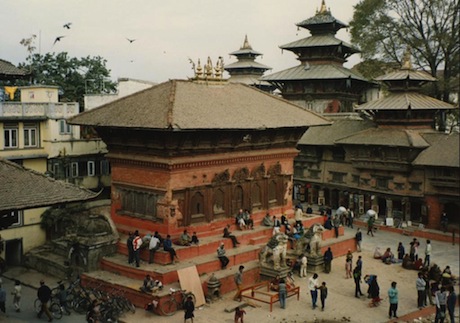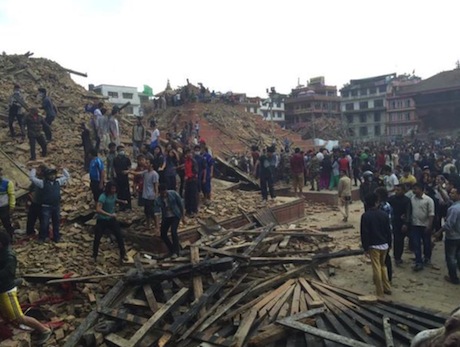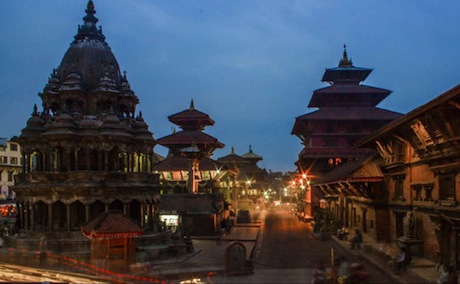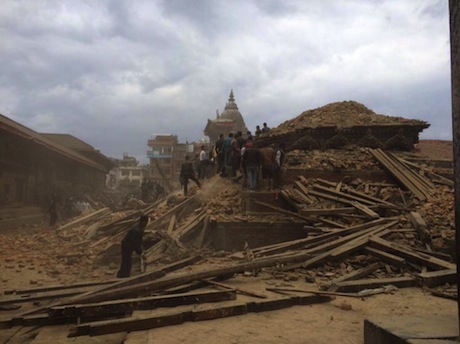The Nepal earthquake was a magnitude 7.8 (Mw) earthquake that occurred at 11:56 NST (6:11:26 UTC) on Saturday 25 April 2015, with the epicentre approximately 34 km (21 mi) east-southeast of Lamjung, Nepal, and the hypocenter at a depth of approximately 15 km (9.3 mi). It is the most powerful earthquake to have hit Nepal since the 1934 Nepal–Bihar earthquake. As of this writing over 1,900 people are known to have died as a result of the earthquake with casualties reported in Nepal and adjoining areas of India, China, and Bangladesh. It was the deadliest day on Mount Everest, surpassing the death toll in the 2014 Mount Everest avalanche.
Centuries-old buildings were destroyed in the UNESCO World Heritage sites in the Kathmandu Valley, including some at Kathmandu Durbar Square. Rubble is what remains after the devastating earthquake hit. Paris-based writer Radha Kapoor Sharma (@radhakaps) posted the following before-and-after photos of the once beautiful ancient city on Twitter.

| SUPPORT INDEPENDENT SOCIAL COMMENTARY! Subscribe to our Substack community GRP Insider to receive by email our in-depth free weekly newsletter. Subscribe to our Substack newsletter, GRP Insider! Learn more |



The earthquake was initially reported as 7.5 Mw by the United States Geological Survey (USGS) before it was quickly upgraded to 7.9 Mw and finally downgraded to 7.8 Mw. The China Earthquake Networks Center (CENC) reported the earthquake’s magnitude to be 8.1 Ms. The India Meteorological Department said two powerful quakes were registered in Nepal at 06:11 UTC and 06:45 UTC.
The first quake measured 7.9 points on the open-ended Richter scale and its epicenter was identified at a distance of 80 km to the northwest of the capital Kathmandu. The second earthquake was somewhat less powerful at 6.6 points on the Richter scale. The seismic focus lay at a depth of 10 km (6.2 mi) below the earth’s surface. Bharatpur was the nearest major city to the earthquake, 53 km (33 mi) from the epicenter; this second earthquake occurred 81 km (50 mi) northwest of Kathmandu, the capital of Nepal. Over twenty eight aftershocks of magnitude 4.5 Mw or greater occurred following the initial earthquake, including one of magnitude 6.6 Mw, which occurred a few minutes after the earthquake.
Nepal is a developing country with a low income economy, ranking 145th of 187 countries on the Human Development Index (HDI) in 2014. It continues to struggle with high levels of hunger and poverty.
The country is prone to frequent earthquakes, with major earthquakes occurring every 1000 years. The collision between the Indian subcontinent and the Eurasian continent, which started in Paleogene time and continues today, produced the Himalaya and the Tibetan Plateau. Nepal lies completely within this collision zone, occupying the central sector of the Himalayan arc, nearly one third of the 2,400 km (1,500 mi)-long Himalayas.
The Indian plate continues to move north relative to Asia at the rate of approximately 50 mm (2.0 in) per year.[73] Given the great magnitudes of the blocks of the Earth’s crust involved, this is remarkably fast, about twice the speed at which human fingernails grow. As the strong Indian continental crust subducts beneath the relatively weak Tibetan crust, it pushes up the Himalayan Mountains. This collision zone has accommodated huge amounts of crustal shortening as the rock sequences slide one over another.
[NB: Parts of this article were lifted off the Wikipedia.org articles 2015 Nepal earthquake and Nepal and used in accordance with that site’s Creative Commons Attribution-Share Alike License consistent with the same license applied by Get Real Post to its content. Thumbnail photo source: @CNN on Twitter.]
- This latest Filipino-style ‘anti-corruption’ circus proves that the Philippines needs a serious reboot - November 16, 2025
- Filipinos literal sitting ducks as wind and floods from natural tropical typhoons amplified by years of neglect bear down - November 9, 2025
- Rally NA NAMAN??? - September 20, 2025
It was a strong Tectonic Earthquake. We express our deepest sympathy with the people of Nepal, on this tragedy. May God/Buddha/the Universe show mercy and console them.
We are all part of humanity. No matter what religious faith, we have; where we are living in this Planet Earth;or what kind of way of life, we may have in our own country.
How to help Link
Sometimes the biggest disasters aren’t noticed at all – no one’s around to write horror stories.
So how much aid is Philippines willing to give to them? They got hit bad by natural disasters and were given lots of it. They need to reciprocate back.
Don’t expect much, if anything. Nuf said!
like na lang daw sa facebook post…yun lang naman ang kaya ng mga penoy eh